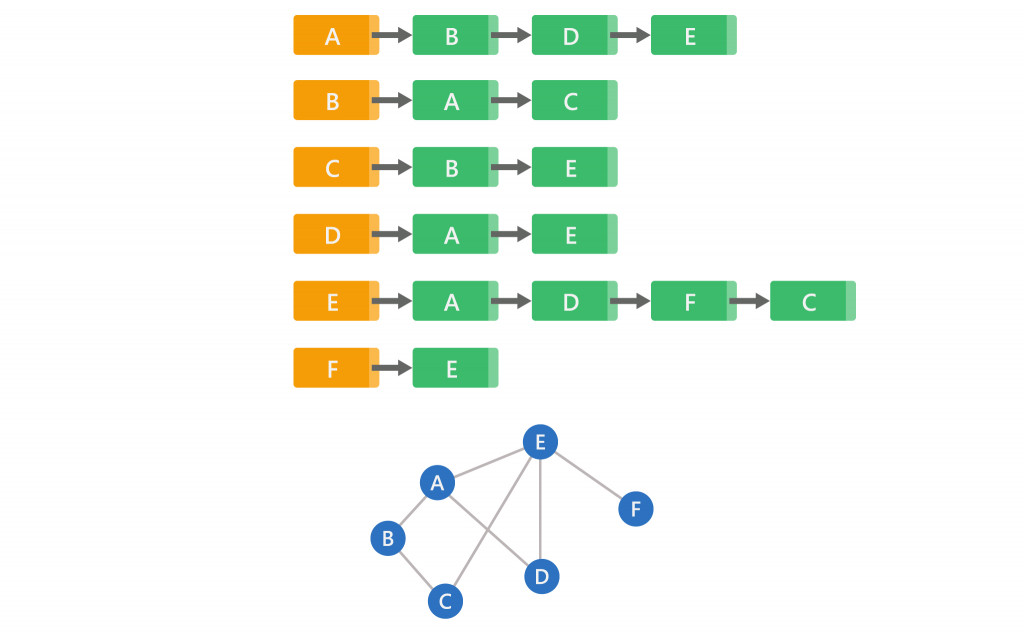深度優先搜尋(Depth-First Search,DFS)與廣度優先搜尋(Breadth-First Search, BFS),是可以用來走訪或搜尋樹節點與圖頂點的演算法,先前介紹的二元樹走訪就是使用上述方法走訪各節點,這邊以圖結構來介紹。
樹的走訪可以參考此篇。
下面相鄰串列構成的圖來示範搜尋
圖的介紹可以參考此篇。
先選定一個頂點開始走訪,接著從此頂點相鄰未被走過的頂點中,擇一走訪標示為記錄點,以此類推,不斷從新記錄點的相鄰未被走過頂點中尋找。
若新紀錄點的相鄰頂點都被走過,則退回前一個紀錄點,繼續從未被走過頂點中尋找。
深度優先可以利用堆疊(Stack)的方式來處理。
堆疊的介紹可以參考此篇。
先選定一個頂點開始走訪,逐一走過此頂點相鄰未被走過的頂點,若相鄰頂點都被走過,再從走訪過的頂點中擇一為新記錄點,逐一走過新記錄點相鄰未被走過的頂點,以此類推。
廣度優先可以利用佇列(Queue)的方式來處理。
佇列的介紹可以參考此篇。
class Graph {
constructor() {
this.adjacencyList = {}
}
//新增頂點
addVertex(vertex) {
if (!this.adjacencyList[vertex]) {
this.adjacencyList[vertex] = []
} else {
return '頂點已存在';
}
}
//新增邊
addEdge(vertex1, vertex2) {
if (this.adjacencyList[vertex1]) {
if (this.adjacencyList[vertex2]){
this.adjacencyList[vertex1].push(vertex2)
this.adjacencyList[vertex2].push(vertex1)
}else {
return '第二項頂點不存在';
}
} else {
return '第一項頂點不存在';
}
}
//刪除頂點
removeVertex(vertex) {
if (this.adjacencyList[vertex]) {
this.adjacencyList[vertex].forEach(function(item) {
this.removeEdge(vertex, item)
delete this.adjacencyList[vertex]
});
} else {
return '此頂點已不存在';
}
}
//刪除邊
removeEdge(vertex1, vertex2) {
if (this.adjacencyList[vertex1]) {
if (this.adjacencyList[vertex2]){
this.adjacencyList[vertex1] = this.adjacencyList[vertex1].filter(
(vertex) => vertex !== vertex2
)
this.adjacencyList[vertex2] = this.adjacencyList[vertex2].filter(
(vertex) => vertex !== vertex1
)
}else {
return '第二項頂點已不存在';
}
} else {
return '第一項頂點已不存在';
}
}
printGraph(){
console.log(this.adjacencyList)
}
//廣度優先
bfs(start) {
const queue = [start];
const result = [];
const visited = {};
visited[start] = true;
let currentVertex;
while (queue.length) {
currentVertex = queue.shift();
result.push(currentVertex);
this.adjacencyList[currentVertex].forEach(neighbor => {
if (!visited[neighbor]) {
visited[neighbor] = true;
queue.push(neighbor);
}
});
}
return result;
}
//深度優先
dfs(start) {
const result = [];
const stack = [start];
const visited = {};
visited[start] = true;
let currentVertex;
while (stack.length) {
currentVertex = stack.pop();
result.push(currentVertex);
this.adjacencyList[currentVertex].forEach(neighbor => {
if (!visited[neighbor]) {
visited[neighbor] = true;
stack.push(neighbor);
}
});
}
return result;
}
}
let graph = new Graph();
graph.addVertex('A');
graph.addVertex('B');
graph.addVertex('C');
graph.addVertex('D');
graph.addVertex('E');
graph.addVertex('F');
graph.addEdge('A', 'B');
graph.addEdge('A', 'D');
graph.addEdge('A', 'E');
graph.addEdge('B', 'C');
graph.addEdge('D', 'E');
graph.addEdge('E', 'F');
graph.addEdge('E', 'C');
graph.printGraph();
//{
// A: ["B", "D", "E"],
// B: ["A", "C"],
// C: ["B", "E"],
// D: ["A", "E"],
// E: ["A", "D", "F", "C"],
// F: ["E"]
//}
console.log(graph.bfs('A'))
//["A", "B", "D", "E", "C", "F"]
console.log(graph.dfs('A'))
//["A", "E", "C", "F", "D", "B"]
console.log(graph.dfs('B'))
//["B", "C", "E", "F", "D", "A"]
console.log(graph.dfs('C'))
//["C", "E", "F", "D", "A", "B"]
console.log(graph.dfs('D'))
//["D", "E", "C", "B", "F", "A"]
console.log(graph.dfs('E'))
//["E", "C", "B", "F", "D", "A"]
console.log(graph.dfs('F'))
//["F", "E", "C", "B", "D", "A"]
#Graph
graph = {
'A': ["B", "D", "E"],
'B': ["A", "C"],
'C': ["B", "E"],
'D': ["A", "E"],
'E': ["A", "D", "F", "C"],
'F': ["E"]
}
def bfs(graph,start):
queue = []
queue.append(start)
result = []
visited = set()
visited.add(start)
while(len(queue)>0):
currentVertex = queue.pop(0)
result.append(currentVertex)
for neighbor in graph[currentVertex]:
if neighbor not in visited:
queue.append(neighbor)
visited.add(neighbor)
return result
def dfs(graph,start):
stack = []
result = []
stack.append(start)
visited = set()
visited.add(start)
while(len(stack)>0):
currentVertex = stack.pop()
result.append(currentVertex)
for neighbor in graph[currentVertex]:
if neighbor not in visited:
stack.append(neighbor)
visited.add(neighbor)
return result
print(bfs(graph,'A'))
#['A', 'B', 'D', 'E', 'C', 'F']
print(dfs(graph,'A'))
#['A', 'E', 'C', 'F', 'D', 'B']
